This is the weekend edition of TheMarioBlog and will be updated as needed. The next blog is Monday, August 12 (reporting from Argentina)
Update #5: Miami, Florida, Friday, Aug. 9 at 17;19
TAKEAWAY: Amazon’s Jeff Bezos has acquired The Washington Post and now faces the task of preparing that institution to extend its powerful brand naturally to the digital age.
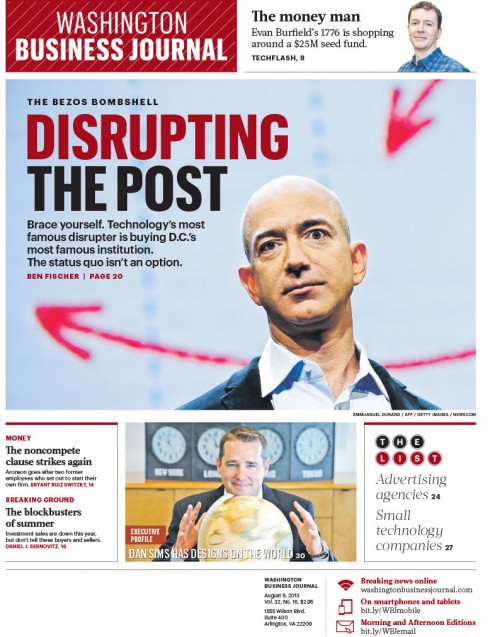
Jeff Bezos made the cover of this week’s Washington Business Journal: The word “disruption” never sounded so positive. See more about our collaboration with WBJ, one of the American City Business Journals weeklies here.
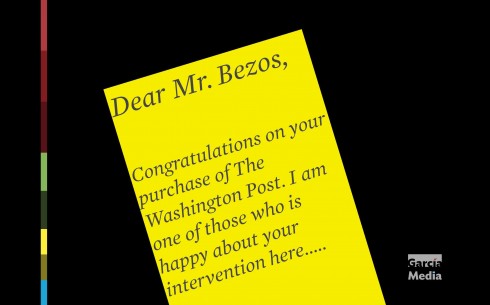
Dear Mr. Bezos,
Congratulations on your purchase of The Washington Post. I am one of those who are extremely happy about your intervention here. Not that the Graham family did not do a wonderful job steering WaPo to its incredibly significant influence as one of the United States’ and the world’s leading newspapers.
However, the one reason I believe your presence at The Washington Post at this point in its history is so vital is because the industry itself finds itself at that exciting (but, to some, problematic) junction which is the nexus of storytelling and technology. In addition, the fact that Donald Graham himself has said that the sale of the newspaper to you is the right thing, means a lot.
The Washington Post is rich in its storytelling tradition, including outstanding visual storytelling (here is a newspaper where the role of photography has always ranked up there with the best of its editorial traditions).
I know, as I have had the honor of working with the WaPo team on its most recent rethink of the Sunday edition, an unforgettable and rewarding experience. However, if I am honest here, it was primarily a design-oriented exercise, when it would have been better to sit down for a rethink, including the role of digital. Better than that, not just the “role”, but how digital/print needed to blend more organically, in what I refer to as iWED (integrated writing/editing/design).
That, however, was not to be at that time, so we rethought the Sunday front page look, improved the use of navigation throughout, better color palette, and all those changes that, while nice, are NOT what will save newspapers in the era of the tablet.
But, returning to why I think your presence will make a difference, and not just for The Washington Post: you understand the nuances of the digital age, but you also respect the historical importance of the newspaper.
You will be able to create a model that many top newspapers worldwide are waiting to see: an extension of a magnificent brand across platforms, one in which the printed newspaper is not the protagonist, but an important part of what I call the media quartet: smartphones, online, print and tablet. Don’t let anyone convince you to shut down the print edition, Mr. Bezos. Instead, take it along and give it its proper place as part of the media quartet. Our most successful projects, including in the US, have involved a revitalization of print while moving with a digital first approach.
Then, something that needs to be done soonest: curated editions for the smartphone and tablet, so that those platforms are explored to their fullest and that glorious brand of The Washington Post can be guaranteed to stay around for a long time offering us the type of storytelling that has already changed history. You see, Mr. Bezos, right now the content from the print edition of WaPo comes as is into the tablet edition, for example. This is, of course, good, but not all that tablet users expect from a true curated tablet edition, in which they expect content especially prepared, with more audio, video, pop ups, and engagement. I believe this is the next logical step as you bring The Washington Post closer to a full fledged multi media brand, extending and enhancing its excellent content to fit the specific needs of the various platforms.
I think you got the right price ($250 million) for what I know will be a great (and tough) challenge. If there is someone who can face it with bravado, that is you.
I know that you will salute the rich past of The Washington Post and carry it by the hand with pride, but moving quickly forward to imagine what the great WaPo will be like 100 years from now. You have it right when you tell the WaPo team that “the values of The Post do not need changing”. However, how those values are preserved and presented in the digital age may require a different journey.
The tools are there to start that journey, and it all begins with one key ingredient, a powerful brand that resonates with audiences of all ages across all platforms, while exploring each platform to its full potential.
We will be watching with interest. My most sincere and best wishes for your success, which will also mean the success of a newspaper brand we are all proud of.
Best of luck, Mario
Of related interest:
Q&A: Steve Coll on the WaPo purchase
http://www.cjr.org/behind_the_news/wapo_qa_steve_coll.php?page=all
Summary:
Steve Coll, the new dean of Columbia’s Journalism School, spent 20 years as a reporter and editor at The Washington Post, serving as the paper’s managing editor from 1998-2004. CJR spoke to him about the sale of the Post to Jeff Bezos, the founder of Amazon.
Newspapers should be more like Amazon: What Jeff Bezos can teach The Washington Post
http://www.newrepublic.com/article/114251/jeff-bezos-should-run-washington-post-amazon
First paragraph:
What’s intriguing about Jeff Bezos, who purchased The Washington Post this week, is not that he’s a digital guy or that he has a lot of money—though both certainly help—but that ever since he founded Amazon, he’s specialized in the long view. The company lost money for nine years, and Bezos continues to prioritize long-term investment over near-term profit. That’s how great, enduring companies are created or transformed—by building a strong infrastructure, products, brand, and deep relationships with customers. And to their credit, Amazon shareholders are rewarding this strategy and vision. They know there will be time enough to see returns on these investments, returns that will reflect the massive value Bezos is building.
Mario with Tyler Brulé in Monocle 24 Radio’s The Stack this Saturday
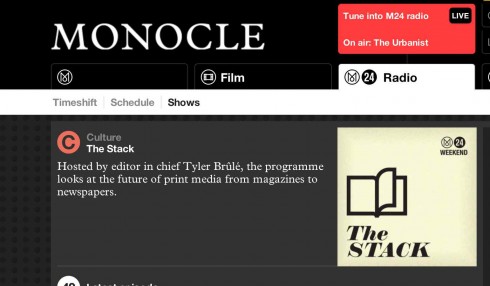
I will appear in Tyler Brulé‘s show, The Stack, Saturday, August 10, at 10 a.m. (London Time).
This will be a discussion of Jeff Bezos’ acquisition of The Washington Post and what it means for the Post and for the industry at large.
You can listen to the program live here:
http://monocle.com/radio/shows/the-stack/
Download the show anytime after the show has aired.
Weekend reads of interest
Jon Wile on Redesigning the American City Business Journals
http://www.snd.org/2013/08/jon-wile-on-redesigning-the-american-city-business-journals/
State of Journalism Education 2013 (from The Poynter Institute for Media Studies
http://www.newsu.org/course_files/StateOfJournalismEducation2013.pdf
Highlight:
Today, 96 percent of those who
identify themselves as journalism
educators believe that a journalism
degree is very important to
extremely important when it
comes to understanding the
value of journalism. That’s almost
identical to the 2012 result.
Professionals [editors and those
who work in journalism] have a
less favorable opinion, with 57
saying that a degree is valuable to
extremely valuable when it comes
to understanding the value of
journalism. That’s unchanged from
last year’s survey
Stuff we like
New York Magazine
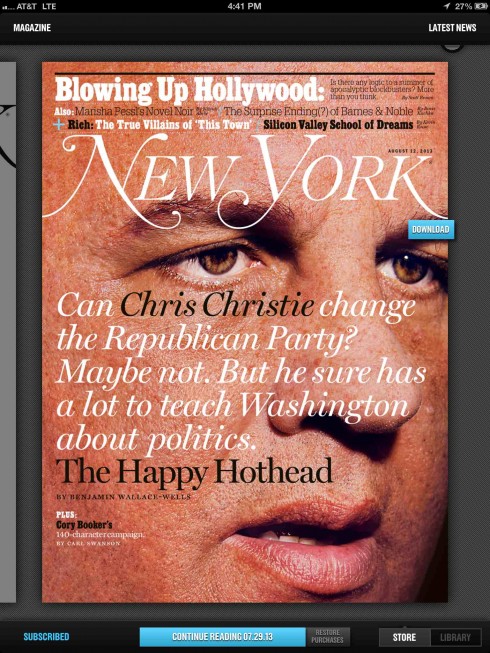
Latest issue of New York Magazine, iPad edition
This new edition of New York magazine (on iPad) has a striking, but simple, cover, featuring New Jersey Governor Chris Christie and asking the question: can he change the Republican Party?
It is a mask crop of the Governor’s face, along with nice, easy to read type. A photo attack and a type attack on the same cover, and it works well.
L’Equipe (France)
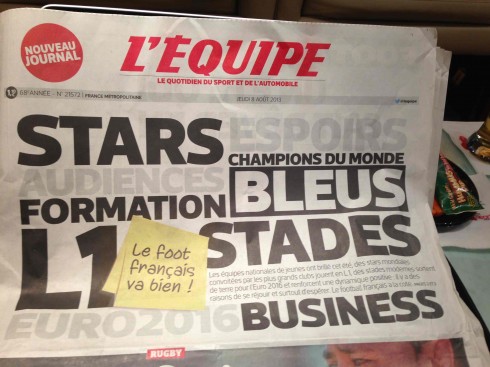
L’Equipe of Thursday, August 8
And the French sports daily L’Equipe goes for a full type attack on its front page of Thursday, August 8, showing that sometimes it is pure type, and not a photo, that can do the trick, even in a sports-only daily